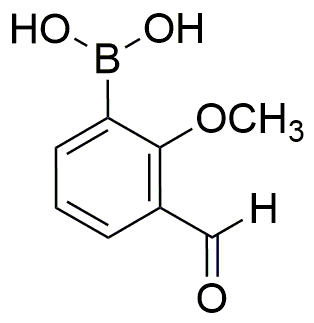3-Formyl-2-methoxyphenylboronic acid is widely utilized in research focused on:
- Organic Synthesis: This compound serves as a versatile building block in organic synthesis, enabling the creation of complex molecules for pharmaceuticals and agrochemicals.
- Drug Development: It plays a crucial role in medicinal chemistry, particularly in the development of targeted therapies for various diseases, including cancer.
- Materials Science: The compound is used in the fabrication of advanced materials, such as polymers and nanomaterials, enhancing their properties for industrial applications.
- Bioconjugation: It is valuable in bioconjugation processes, allowing researchers to attach biomolecules to surfaces or other molecules, which is essential in diagnostics and therapeutic applications.
- Sensor Technology: This chemical is applied in the development of sensors, particularly for detecting biological molecules, providing a sensitive and specific means of analysis in clinical settings.
Informations générales
Propriétés
Sécurité et réglementation
Applications
3-Formyl-2-methoxyphenylboronic acid is widely utilized in research focused on:
- Organic Synthesis: This compound serves as a versatile building block in organic synthesis, enabling the creation of complex molecules for pharmaceuticals and agrochemicals.
- Drug Development: It plays a crucial role in medicinal chemistry, particularly in the development of targeted therapies for various diseases, including cancer.
- Materials Science: The compound is used in the fabrication of advanced materials, such as polymers and nanomaterials, enhancing their properties for industrial applications.
- Bioconjugation: It is valuable in bioconjugation processes, allowing researchers to attach biomolecules to surfaces or other molecules, which is essential in diagnostics and therapeutic applications.
- Sensor Technology: This chemical is applied in the development of sensors, particularly for detecting biological molecules, providing a sensitive and specific means of analysis in clinical settings.
Documents
Fiches de données de sécurité (FDS)
La FDS fournit des informations de sécurité complètes sur la manipulation, le stockage et l’élimination du produit.
Spécifications du produit (PS)
Le PS fournit une description complète des propriétés du produit, notamment sa composition chimique, son état physique, sa pureté et les exigences de stockage. Il détaille également les plages de qualité acceptables et les applications prévues du produit.
Certificats d'analyse (COA)
Recherchez des certificats d'analyse (COA) en saisissant le numéro de lot du produit. Les numéros de lot et de lot se trouvent sur l'étiquette d'un produit, après les mots « Lot » ou « Lot de fabrication ».
Numéro de catalogue
Numéro de lot/série
Certificats d'origine (COO)
Ce certificat d'exploitation confirme le pays dans lequel le produit a été fabriqué, et détaille également les matériaux et composants utilisés et s'il est issu de sources naturelles, synthétiques ou autres sources spécifiques. Ce certificat peut être requis pour les douanes, le commerce et la conformité réglementaire.
Numéro de catalogue
Numéro de lot/série
Fiches de données de sécurité (FDS)
La FDS fournit des informations de sécurité complètes sur la manipulation, le stockage et l’élimination du produit.
DownloadSpécifications du produit (PS)
Le PS fournit une description complète des propriétés du produit, notamment sa composition chimique, son état physique, sa pureté et les exigences de stockage. Il détaille également les plages de qualité acceptables et les applications prévues du produit.
DownloadCertificats d'analyse (COA)
Recherchez des certificats d'analyse (COA) en saisissant le numéro de lot du produit. Les numéros de lot et de lot se trouvent sur l'étiquette d'un produit, après les mots « Lot » ou « Lot de fabrication ».
Numéro de catalogue
Numéro de lot/série
Certificats d'origine (COO)
Ce certificat d'exploitation confirme le pays dans lequel le produit a été fabriqué, et détaille également les matériaux et composants utilisés et s'il est issu de sources naturelles, synthétiques ou autres sources spécifiques. Ce certificat peut être requis pour les douanes, le commerce et la conformité réglementaire.


